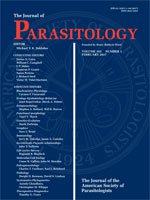The study of fossil parasites can provide insight into the antiquity of host–parasite relationships and the origins and evolution of these paleoparasites. Here, a coprolite (fossilized feces) from the 1.2-million-yr-old paleontological site of Haro River Quarry in northwestern Pakistan was analyzed for paleoparasites. Micromorphological thin sectioning and Fourier-transform infrared spectrometry (FTIR) analysis confirms the coprolite belonged to a bone-eating carnivore, likely the extinct giant short-faced hyena (Pachycrocuta brevirostris). Parasitological analysis shows the coprolite to be positive for Toxocara sp. To our knowledge, this is the earliest evidence for Toxocara sp. found.
How to translate text using browser tools
1 February 2017
Earliest Evidence of Toxocara sp. in a 1.2-Million-Yr-Old Extinct Hyena (Pachycrocuta brevirostris) Coprolite from Northwest Pakistan
Angela R. Perri,
Susann Heinrich,
Shira Gur-Arieh,
Jeffrey J. Saunders
ACCESS THE FULL ARTICLE

Journal of Parasitology
Vol. 103 • No. 1
February 2017
Vol. 103 • No. 1
February 2017




